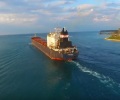It’ll take more than Hanjin’s crisis to fix shipping’s capacity problem: Expert

The crisis surrounding Hanjin Shipping has rocked the industry, but even more shipping lines could find themselves in trouble thanks to the huge amount of overcapacity in the industry, warns the CEO of a logistics company.
Hanjin, which had around 3 percent of market share in shipping, filed for court receivership at the end of August, which has meant that its ships have been denied access to ports and, in some cases, have been seized.
One result of Hanjin’s troubles is that shipping rates have spiked. Prices for shipments between Asia and the U.S. have risen 50 percent through September, according to data from Freightos, an online shipping rate marketplace. However, this is likely to prove temporary, as prices will fluctuate and currently empty container slots are brought into use, the company added.
Not only have shipping rates risen, but companies which were using Hanjin have received charges from some ports, according to Philip Damas, director for supply chain advisors at Drewry.
“Some ports have imposed surcharges on exporters and importers who used Hanjin as a carrier and are waiting for their products in the destination port to cover the port costs unpaid by Hanjin. This is also increasing exporters’ costs,” he told CNBC in an email.
Hanjin has been a shock to the system, but a glut in the number of ships carrying goods around the world is still an issue, warns Dr. Zvi Schreiber, CEO of Freightos, an online logistics marketplace.
“There has been a significant overcapacity, which is why rates have been so low and that’s why Hanjin went bankrupt in the first place, but it’s not clear if that’s enough,” Schreiber told CNBC in a phone interview on Thursday.
“Hanjin is only 3 percent of world trade and it seems the overcapacity in the industry is more than that. This is just one of the painful steps for the industry correcting its overcapacity, but there may be more.”
The shipping industry is in dire straits. Because of overcapacity, shipping rates have fallen and the value of vessels has dropped. A market report released last week by market analyst’s VesselsValue showed that the total number ships being sold for demolition for all ship types had risen 50 percent this August, compared to the same month last year.
Schreiber outlined three scenarios which may help solve the overcapacity issue: economic growth; further collapse; or consolidation.
“Perhaps the world economy will get back into growth and catch up with capacity, which would be the best solution for everyone. If there’s economic growth and people are buying more products again, then you can utilise the capacity better,” Schreiber said.
“I’m afraid we’ll see more collapse,” he warned. “There could easily be another bankruptcy or two. I hope not, but that certainly can happen.”
Shipping companies are likely to merge and consolidate, and this could support prices, according to Damas.
“We expect that the rapid consolidation of the shipping line industry through carrier failures and M&As, the inability of most shipping lines to continue the current price war and the possible avoidance by exporters of financially vulnerable shipping lines will push shipping rates up even after the short-term market shock caused by Hanjin,” he said.
However, Schreiber warned that consolidation may have some negative consequences.
“If you have consolidation and fewer players, they could find it easier to fix prices and keep them high, which would be good for them, but we don’t want to go back to a situation of cartels and price fixing in the industry,” said Schreiber.
Source: CNBC
HEADLINES
- Do shipping markets want Biden or Trump for the win?
- All 18 crew safe after fire on Japanese-owned tanker off Singapore
- Singapore launching $44m co-investment initiative for maritime tech start-ups
- Cosco debuts Global Shipping Industry Chain Cooperation Initiative
- US warns of more shipping sanctions
- China continues seaport consolidation as Dalian offer goes unconditional